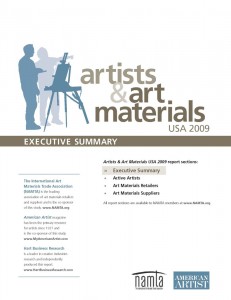CAA News Today
New Industry Report by NAMTA on Artists and Art Materials
posted Nov 03, 2009
 A recent study on artists and their materials has been published by the International Art Materials Trade Association (known as NAMTA) and American Artist magazine, in conjunction with Hart Business Research. Based on a spring 2009 survey of artists, students, and the retailers and suppliers of art materials, “Artists & Art Materials USA 2009” is the first report published in over a decade that analyzes industry size and trends, business practices, and artist needs.
A recent study on artists and their materials has been published by the International Art Materials Trade Association (known as NAMTA) and American Artist magazine, in conjunction with Hart Business Research. Based on a spring 2009 survey of artists, students, and the retailers and suppliers of art materials, “Artists & Art Materials USA 2009” is the first report published in over a decade that analyzes industry size and trends, business practices, and artist needs.
The most groundbreaking finds published in this report include an increased use of mixed media and digital media, the importance of arts education for both children and practicing artists, and the continued use of magazines and books as a primary source of learning. The results of the survey show that artists are purchasing larger amounts of “nontraditional” art materials such as fabrics, glass, and beads, using more digital products, and incorporating scavenged materials. In 2008, the percentage of artists spending for nontraditional art supplies was almost equal to that for paints.
Unsurprisingly, the study found that artists are increasingly using computers either to create digital art or to assist them in producing nondigital art. However, many artists favor printed materials such as art magazines to their website counterparts as a source for education. Eighty-seven percent of survey participants said they read art-related magazines, making these publications the top source for learning, followed closely by books. Early exposure to art is crucial: well over half of the professional artists who participated in the survey responded that art was a major part of their lives by age 12. The report urges for the support of elementary school art teachers in order to expose children to art at a young age.
The 4.4 million active artists in the United States—professionals, students, and hobbyists—are spending over $4 billion per year on art materials and services. While 28 percent of artists buy their supplies online, almost twice as much shopping (54 percent) occurs at brick-and-mortar businesses. Also, while stores are meeting artists’ need for drawing and painting supplies, an increasing number of practitioners are spending more for classes and workshops, an area underserved by retailers and suppliers.
A free download of the eight-page executive summary is available from NAMTA.


